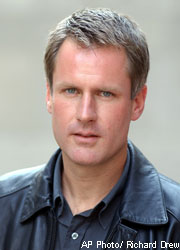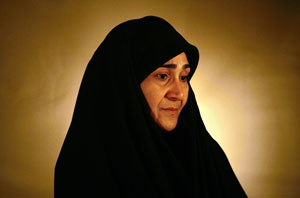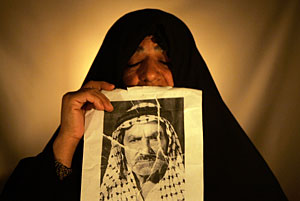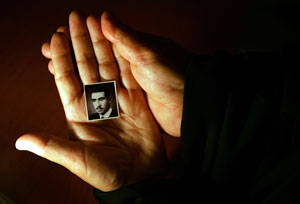 |
 | |||||||||||||
The Widows of Dujail
|
 |
||||||||||||
|
This October I set out to photograph the widows of Dujail, a series of simple portraits of the women left behind after Saddam Hussein's forces rounded up their fathers, husbands and sons in retaliation for a 1982 assassination attempt against him. The widows live in the mostly Shia town of Dujail, about 45 minutes' drive north of Baghdad. The bodies of their loved ones have never been found.
The logistics of photographing the widows were complex, both in locating the women and also in ensuring it would be safe for me to photograph them. I contacted a translator for the municipal Dujail government. Mohammed knew the head of a local organization dedicated to helping those persecuted under the Saddam regime and he got me a list of names and addresses of the widows. We put together a team of local people to organize the women and transport them to a safe venue for a photo session at an appointed time.
For security, I counted on the U.S. Army. I arranged a military embed with the 1st Brigade Combat Team of the U.S. 42nd Infantry Division. These were a group of National Guardsmen who had spent almost a year patrolling Dujail and the surrounding area. The soldiers, who had hosted very little press during their deployment, welcomed me and did everything to help me pull off the project. I set up a time, and was given a platoon of soldiers from the Alpha Company to serve as my escort to the designated location in Dujail. The soldiers provided security for the photo session.
Then I had to scout around for a room to use as a photo studio, another challenge. I looked for a room with few windows, which my team would cover with opaque cloth to darken the scene. I soon found the perfect room, but we had to remove an ornate collection of overstuffed Louis XIV sofas before we could get to work. I had arranged for half a dozen kerosene lanterns for the lighting. I wanted it to look stylized, and in a war zone without regular electricity you learn to work with what you have available.
I didn't really know what to expect. I thought maybe 20 women would show up for the shoot. But maybe none would come, fearing retaliation. Aside from the intimidating ring of American soldiers outside the perimeter of the building, there were other reasons for them to stay away. Almost everyone in Dujail is afraid. It's a Shia town surrounded by a hostile Sunni countryside. The nearby city of Balad had been devastated by car bombs, killing more than 100 people, mostly Shias, only a month before. With Saddam on trial, and many of the witnesses from Dujail, many expected the town to be targeted by insurgents.
But as we finished preparations for the photo session, I saw, to my surprise, a steady stream of women, shrouded in black, filling the theater of the building, which we used as a waiting room and where we took down their personal information.
They held up their portraits, some of them large colorized photos, clutching them to their chests. Others just brought black-and-white passport photos - the only images of their husbands not confiscated by Saddams's forces - as tiny momentos of a life, a person they had loved long ago.
I tried to spend as much time with each subject as I could, shooting many photos, knowing that at 1/10 of a second many of the images would not be sharp. I directed my assistants to adjust the lanterns, sometimes setting them on a desk in front of the women, other times holding them up on the sides. Always there was a lone lamp behind, lighting a tan backdrop gaffer-taped to the wall.
Halfway through the shoot, I realized that instead of the 20 or so women I had expected, more than 60 came out to be photographed. The four hours allotted me by the military, which, to be fair, was generous, was going to run far short of the time I needed to photograph each widow. I asked the soldiers for an additional two hours, and after a few minutes on the radio, the staff sergeant returned and said I could keep shooting - we could stay.
So as lawyers in the Saddam trial are killed, and many witnesses fear taking the stand against him for obvious reasons, the widows of Dujail turned out to give their testimony - in the form of a simple portrait.
But before sitting for their photos, each had filled out a form which asked a few questions for caption information - basic things like their names and ages, the professions of their husbands, etc. Their answers differed greatly - some were young, others old, some teachers, others farmers. But to one question there was unanimity among the widows of Dujail: "What should happen to Saddam after the trial?" "Execution," they answered, every last one of them.
© John Moore
Dispatches are brought to you by Canon. Send Canon a message of thanks. |
|||||||||||||
Back to December 2005 Contents
|
|




